IIP Homework n°1 > **Homework** **n°1** **:** **HydraulicTurbines** *Letourneau* *Lyana* > */* *2021257413* > > *Itegration* *and* *Intensification* *of* *Process* Introduction I will complete the page on hydraulic turbines, I will refresh or complete the data on the page. And focusing my research and additions on tidal turbines. And finally I will also add a section on hydraulics inPortugal. HydraulicsTurbines **Hydroelectricity** **in** **the** **history** **and** **in** **the** **world** The use of hydraulic turbines began a long time before hydroelectricity: the first watermills appeared in the 1st century, between Greece and Turkey, before reaching the Roman and ChineseEmpires in the 3rd century. Ahydraulic turbine is a rotating machine that produces mechanical energy from moving water, in lakes, rivers or with the tide. So it is a machine that converts kinetic energy and potential energy of water into mechanical work. It is the essential component of hydroelectric power stations intended to produce electricity from a flow of water. Subsequently, its use was adapted to directly drive machines in factories until they were practically used only to drive electric generators. Hydroelectric energy is one of the oldest sources of electricity production, and therefore is very technologically developed. It is today by farthe leadingrenewable electrical energy, producing nearly 83%ofrenewable electricity and 16% of global energy in the world. Hydroelectricity is not the “out of date” science that we imagine. Today, hydraulic machines are high-tech objects that must meet increasingly stringent performance constraints. \[1\] 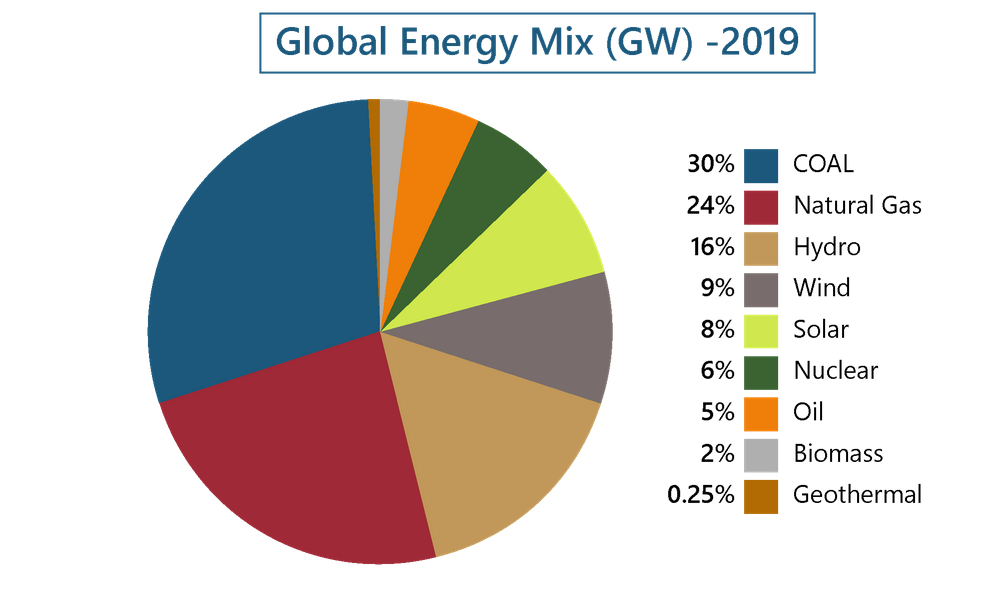 > *Figure* *1:* *Global* *Energy* *Mix* *in* *2019* > [*<u>link</u>*](https://powertechresearch.com/competing-during-transformation-how-private-equity-firms-are-utilizing-market-research-in-energy-sector/) **Constitution** **and** **Operating** **Principles** The water present in a tank located at a higher level (with more energy) is circulated to a lower level (with less energy) passing through a set of curved blades, nozzles or injectors that transform this energy from the water into movement of a rotor,removingenergyand speed from the water. These blades can be staticor fixed on therotor, both being adjustable so that the flowand power generated can be controlled, according to the rotation speed. For its part, the rotoris supported axially by thrust and counter thrust bearings and radially by guide bearings. The pipe normally has a final diameter greater than the initial one, in order to promote the exit of water with a lower velocity \[2\]. To better understand how a turbine works, consider a Francis turbine, illustrated in this video: [<u>video</u>](https://www.youtube.com/watch?v=Q0F-9HciA-A) **Types** **of** **turbines** Different types of turbines are developed to extract mechanical energy from hydraulic energy to generate electricity. They are severalwaysto classify turbines, but a common way isto classify with the mode ofenergy exchange between the water and the turbines. \[1\] *Impulse* *Turbines* If the turbine wheel is driven by the kinetic energy of the fluid that strikes the turbine blades through the nozzle or otherwise, the turbine is known as an impulse turbine. > These types of turbines are usually suitable for high head and low > flow rates. *Reaction* *Turbines* If the sum of potential and kinetic energy of water which are due to the pressure and velocity, respectively cause the turbine blades to rotate, the turbine is classified as a reaction turbine. In these types of turbines, all the turbine is immersed in water and changes in water pressure with the kinetic energy of the water cause power exchange. > Those turbines are usually at lower heads and higher flow rates than > impulse turbines. > > 2 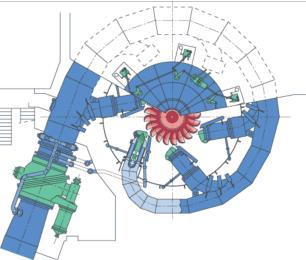 style="width:1.53153in;height:1.30417in" />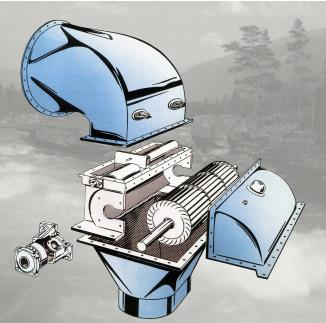 style="width:1.63125in;height:1.61736in" />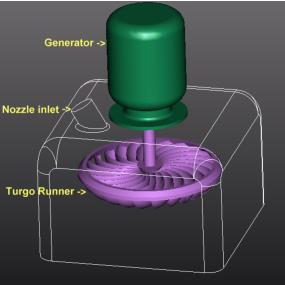 style="width:1.42639in;height:1.42778in" />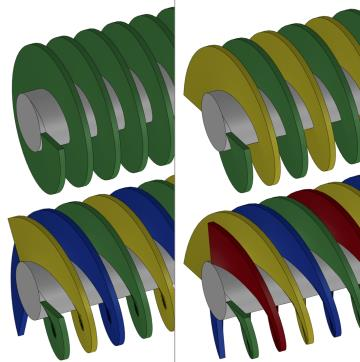 style="width:1.80069in;height:1.81069in" />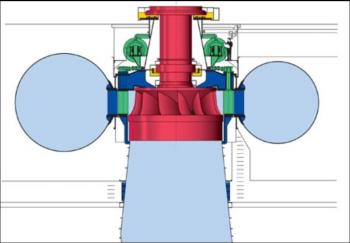 style="width:1.75333in;height:1.21667in" />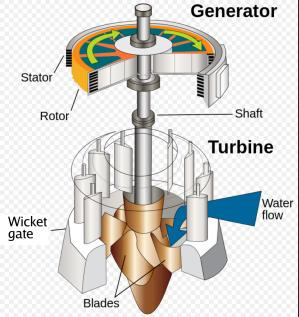 style="width:1.49653in;height:1.5875in" />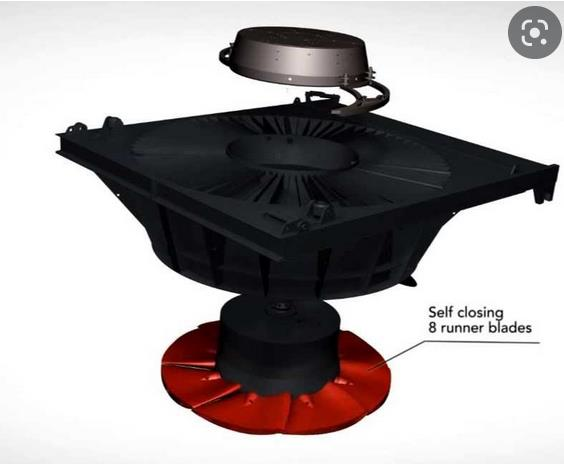 > 3 > *Table* *1* *:* *Types* *of* *turbine* **Choice** **of** **Turbine** **Type** Each type of turbine has its advantages depending on the operating conditions, and the main objective is always to use the equipment that presents the best efficiency for the place where it is installed. Furthermore, the choice of turbine type is also influenced by the turbine speed, that is, by the number of revolutions per minute of the generator driven by theturbine.It isalso worthnotingthat theturbines can be mountedin different positions,with theaxisvertical, horizontal or even inclined to the vertical in order to satisfy the requirements of generated power, water level and space limitations. 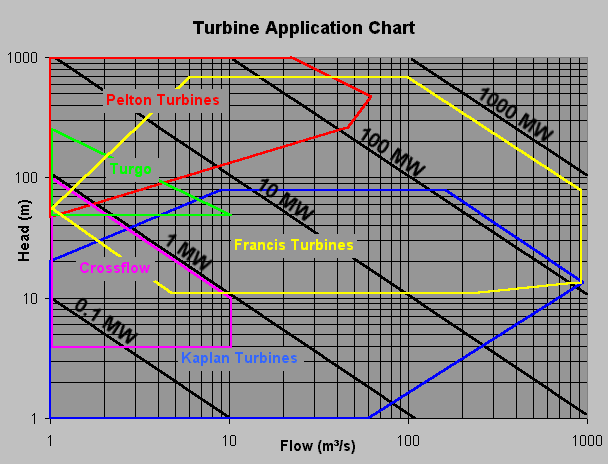 > *Figure* *2* *:* *Turbine* *application* *chart* > [*<u>link</u>*](https://en.wikipedia.org/wiki/Water_turbine) The specific speed of a turbine is given by the manufacturers, and refers to the point of maximum efficiency, it is the best parameter to choose a turbine when conditions of flow and head are established. This allows accurate calculations of turbine performance for a range of head and flow rates. It can be defined as the speed of an ideal similar turbine that would produce one unit of power for one unit of head. 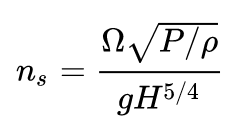 > 4 IIP Homework n°1 with : Ω: angular velocity (rad/s) P: power (W) The efficiency of a turbine is given by the ratio between the mechanical power provided by the turbine and the existing power in the fluid, provided by the hydraulic energy, depending on several variables: > • Flow > > • Existing losses • Turbine power • Manufacturer • Mounting shaft • > Among others However, hydraulic and mechanical losses are the main causes for the low efficiencies in these equipment, and the efficiency of each equipment must be maximized according to the conditions in which it will operate (flow and losses). The typical efficiencies at which a turbine operates vary between 80% and 95%, depending on the flow rate as you can see on graphs identical to the one shown in Figure 2 \[3\]. **Advantages** **of** **Using** **Hydraulic** **Energy** > • Hydraulic energy, a renewable energy source, is a “clean” energy, > because it does not pollute the air and water like power plants that > use fossil fuels as a source of energy; > > • Hydraulic energy is available when it is needed, and engineers can > control water flows through turbines to produce electricity; > > • Hydraulic power stations create large reservoirs (dams) that > contribute to the supply of water for public access and flood control; > > • Energy production involves low costs; > > • They work for decades with little maintenance, not requiring much > investment to be maintained \[4\]. **Disadvantages** **of** **Using** **Hydraulic** **Energy** > • Hydraulic power stations can be affected in times of drought and > cannot produce electricity. > > • The new hydraulic power stations impact the local environment, > destroying ecosystems. > > • Fish populations can be affected, as they can no longer migrate > upstream to spawn, or downstream to go to the ocean \[4\]. **Tidal** **Turbines** From the end of the 19th century, some scientists had the idea of using the mechanical energy of ocean currents, but it is only since the beginning of the 21st century that this source of energy has begun to be studied more seriously: And tidal turbines were born. > 5 IIP Homework n°1 Tidal energy is often compared to wind energy because of its appearance and mode of operation: Concretely, a tidal turbine is composed with a rotor, this is the rotating part, with a propeller made up of blades, with a diameter between 10 and 20 m, all mounted on a shaft/stator, the fixed part. \[5\] The installation of a tidal turbine can be carried out: > • On a mast or on a tripod which allows the tidal turbine to be placed > on the seabed. > > • If the tidal turbine is placed facing an average sea current of 2.5 > m/s, i.e. 5 knots, because the tidal turbine operates at full power > from 4 knots. > > • If the tidal turbine has a current interception surface of around > 300 meters. The operation of a tidal turbine can be broken down as follows: > 1\. The sea current causes the rotation of the blades of the > propeller, drives a turbine which generates a mechanical movement. The > turbine in both directions of the sea current. > > 2\. The rotation of the turbine drives an alternator, which will > convert mechanical energy into electricity. 3. This electricity in the > form of alternating current is then transported by cables to the > surface. > > 4\. The current is then transformed by a converter to be sent to the > electrical network. || || || || || || > *Table* *2* *:* *Tidal* *turbines* *advantages* *and* *limits* *\[6\]* **Au** **Portugal** In 2019, Portugal had 7,193 MW of hydroelectric power plants, i.e. 2.9% of European hydroelectric installed capacity and 0.5% of the world total, 19.1% of the country's total electricity production. Its production reached 10.6 TWh, or 1.6% of the European total, far behind Norway (125.8 TWh), France (63.6 TWh) or Spain (26.4 TWh). In March 2018, renewable energies produced 100% of electricity consumption, including 55% for hydroelectricity in Portugal. \[7\] > 6 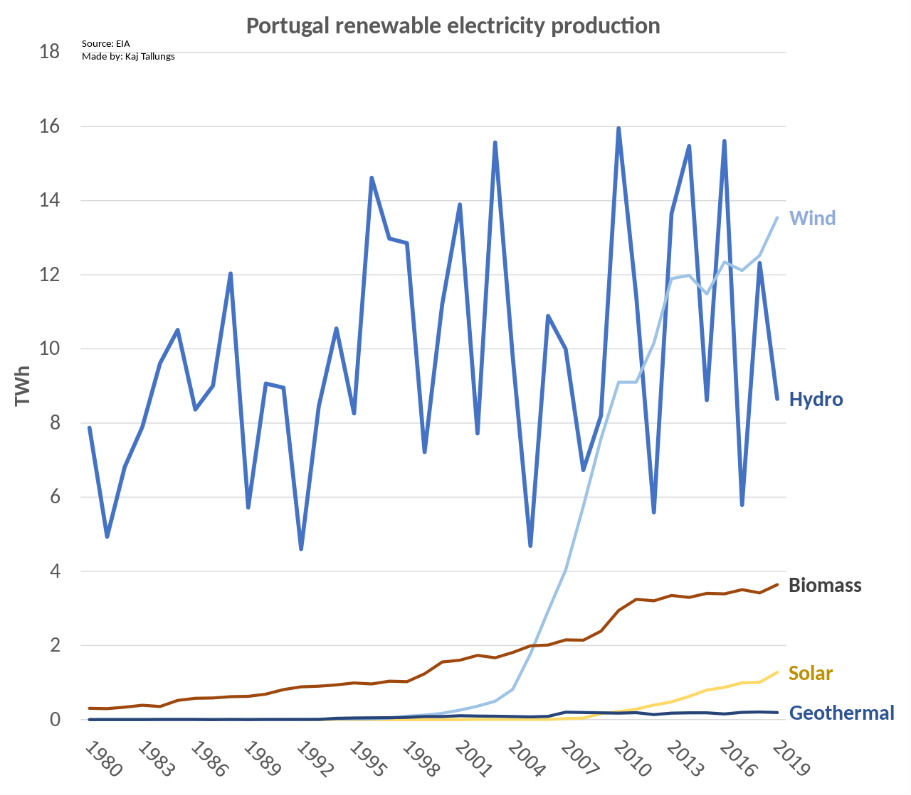 > *Figure* *3* *:* *Portugal* *renewable* *electricity* *productio*[*n* > *<u>link</u>*](https://en.wikipedia.org/wiki/Energy_in_Portugal) Hydroelectric power stations in the country: > • The Frades II (780 MW) and Foz Tua (270 MW) pumped storage power > plants were comissioned in 2017. The Frade II project is one of the > main pumped storage projects in Europe. This project was added to the > cascade of hydroelectric works Cavado-Rabagao, in the north of the > country. > > • The Alqueva dam in the Alentejo created the largest artificial lake > in Western Europe and was one of the country's biggest investments. > This hydroelectric plant, commissioned in 2004, had a power of 518 MW > in 2013. > > • The Aguieira dam, on the Mondego river, was commissioned in 1981, it > has an installed capacity of 270 MW with 3 groups of reversible > Francis turbines. > > • The Douro hydroelectric development has 6 power stations with a > total installed capacity of 3,161 MW. The most important is that of > the Aldeadávila dam, inaugurated in 1963, it has a power of 1,140 MW. > It is the most powerful power plant in Spain and Portugal. > > • On December 19, 2019, EDP and Engie sign launch the construction of > six dams. These six dams, with a total capacity of 1.7 GW, are now in > the Douro Valley. EDP therefore remains the leader in hydroelectric > energy in Portugal with a market share of 65% in the country. 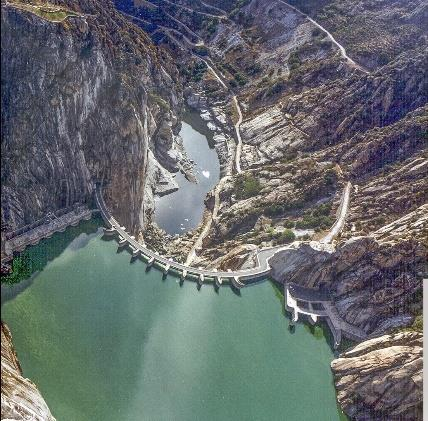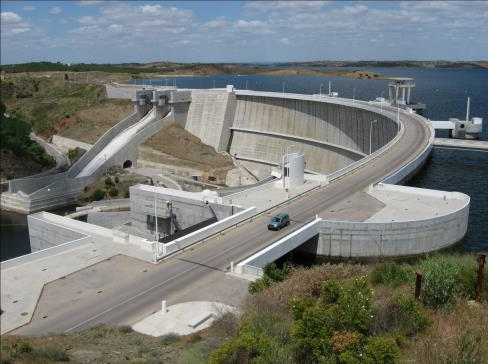 *Picture* *1* *:* *The* *Alqueva* *dam* *in* *the* *Alentejo* *(* *518* *MW)* *Picture* *2* *:* *The* *Aldeadávila* *dam* *in* *the* *Duoro* *(1* *140* *MW)* > 7 IIP Homework n°1 **Some** **Hydraulic** **Turbine** **Manufacturers** There are several manufacturers of hydraulic turbines, namely Voith, Hacker, HISA, Watec-Hydro e.K., among many others that can be found on the following website: [<u>Manufacturers of Hydraulic Turbines</u>.](https://www.industrystock.es/es/empresas/Tecnolog%C3%ADas-de-accionamiento/Tecnolog%C3%ADas-de-turbinas/Turbinas-hidr%C3%A1ulicas) **References** Hydraulic Turbine : [<u>\[1\]</u>](https://en.wikipedia.org/wiki/Water_turbine) [<u>\[2\]</u>](https://pt.wikipedia.org/wiki/Turbina_hidr%C3%A1ulica) \[3\] [<u>Tipos de Turbina</u>](http://www.antonioguilherme.web.br.com/Arquivos/turb_hidro.php) \[4\] [<u>Vantagens e Desvantagens da Energia Hidráulica</u>](http://www.envirothonpa.org/documents/19bHydropowerAdvantagesandDisadvantages.pdf) \[5\] [<u>Tidal turbines</u>](https://www.encyclopedie-energie.org/les-hydroliennes/) \[6\] [<u>Tidal Turbines historic</u>](https://fr.wikipedia.org/wiki/Hydrolienne#Historique) \[7\] [<u>Hydraulic in Portugal</u>](https://en.wikipedia.org/wiki/List_of_hydroelectric_power_stations_in_Portugal) > 8
